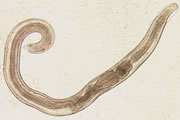Pinworm and Swimming

Pinworm infections are rarely spread through the use of swimming pools. Pinworm infections occur when a person swallows pinworm eggs picked up from contaminated surfaces or fingers. Although chlorine levels found in pools are not high enough to kill pinworm eggs, the presence of a small number of pinworm eggs in thousands of gallons of water (the amount typically found in pools) makes the chance of infection unlikely.
In the United States, pinworm is most common in school-aged and preschool-aged children.
To prevent pinworm:
- Remind your child to wash his or her hands after using the toilet, after playing outside, and before eating.
- Make sure you wash your hands after changing diapers.
- Make sure your child showers or bathes every day and changes his or her underwear or swimsuits daily.
- Keep your child's fingernails short and clean.
- Tell your child not to scratch around his or her bottom or bite his or her nails.
- Change and wash night clothes frequently.
For more information on pinworm, please see CDC's Pinworm Infection page.
Get email updates
To receive email updates about this page, enter your email address:
Contact Us:
- Centers for Disease Control and Prevention
1600 Clifton Rd
Atlanta, GA 30333 - 800-CDC-INFO
(800-232-4636)
TTY: (888) 232-6348 - New Hours of Operation
8am-8pm ET/Monday-Friday
Closed Holidays - cdcinfo@cdc.gov
- For more information, please contact us at healthyswimming@
cdc.gov


